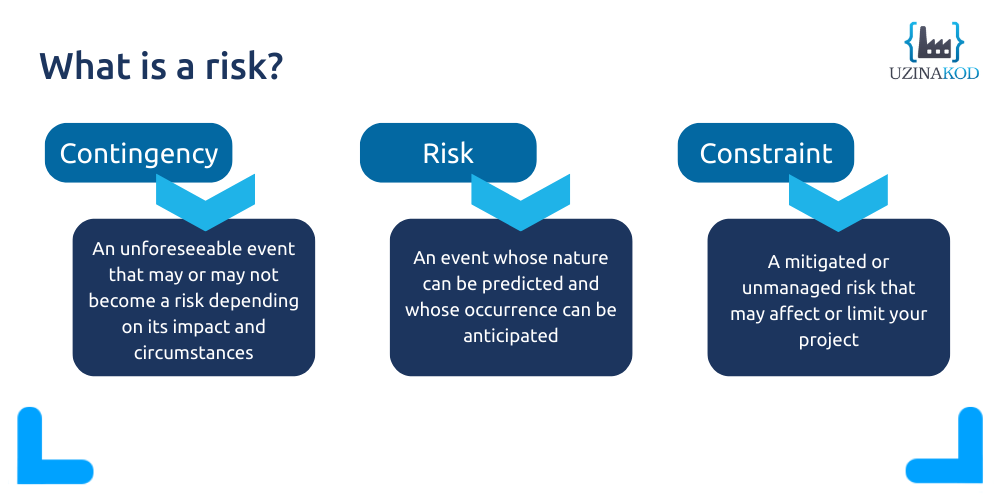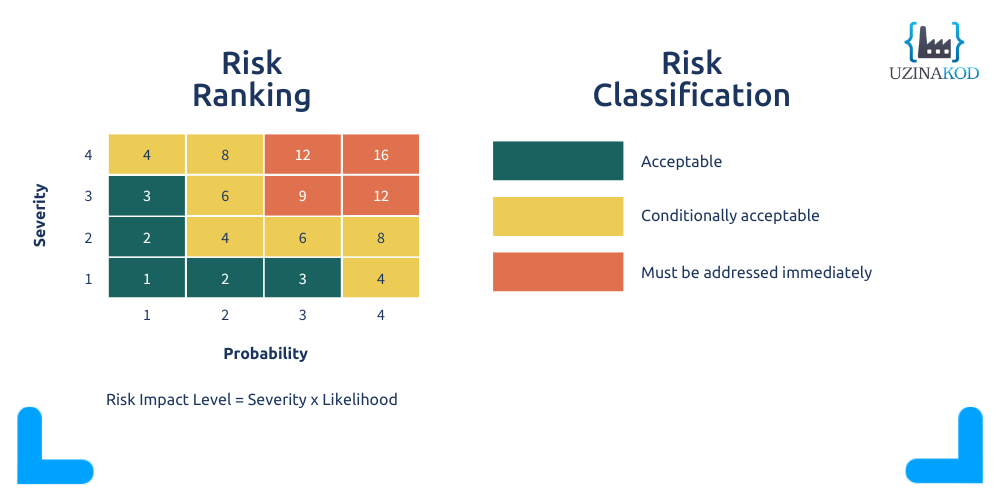When it comes to project management, cost control and deadline management seem self explanatory.
However, there’s another fundamental aspect that influences how we deal with these constraints on a day-to-day basis: risk management.
This concept is rooted in a common principle: all projects, regardless of the field to which they belong and the methodology that governs them, involve risks.
Let’s talk semantics
First of all, it’s important to understand what a risk is.

Still confused? Don’t freak out! The main takeaway here is that risks can be anticipated.
If you can anticipate a risk, you can try to mitigate or eliminate it in order to avoid additional constraints. 😊
When’s the best time to start tracking risks?
Your budget is barely outlined, and your project schedule is far from Gantt-worthy, so you still have lots of time before you need to start thinking about risk management, right? Well, you’re in for a rude awakening. Risks are already looming, just waiting for you and your team to make a mistake.
Here are a few tips that should help:
- The initiation phase is a good time for early risk detection.
- Your experience is a major asset: although each project is unique, some major risk categories are common to all projects, allowing you to capitalize on past risks to better detect future ones.
- Planning ahead reduces potential impacts and cascading risks. What’s more, failure to anticipate a risk can lead to more trouble down the line!
The most important thing to remember is that risk management is a recurring task that begins at the initiation phase of the project and is carried out through the end of the maintenance phase.
Which processes can help you manage your risks effectively?
Like industrial production lines, risks must undergo a standardized management process. This ensures management optimization and therefore offers the greatest chance of success.
1. Identify
How do we identify risks? Alone in front of an Excel workbook trying to pinpoint all possibilities? Fortunately, that’s not how it works!
Risk identification is a team effort. As a Project Manager, you’re not omniscient or clairvoyant, so no one should expect you to accurately predict the future.
Uzinakod’s advice: Set up a weekly internal project review with your teams and involve your Team Leader, Analysts, QA Experts and anyone else with a pertinent role to play by asking simple questions, such as whether they encountered new issues, had good communication throughout the week, or how user testing is coming along.
2. Prioritize
Once you’ve identified potential risks, you need to isolate major ones with your team (and, in some cases, with your client).
Severity is the most common prioritization criterion. Risk ranking is obtained by using a matrix that connects the likelihood of occurrence with the degree of impact on the project.

This doesn’t mean that you should neglect minor risks, but that you should prioritize mitigating or eliminating major ones, as they’re most likely to become a constraint or have a significant impact on your project.
3. Plan
This involves planning actions to mitigate or eliminate risks.
The Project Manager isn’t the only one responsible for planning; it’s a team effort that involves joint deliberation. The mitigation plan must not only be achievable and measurable but also executed within an agreed-upon timeframe.
Uzinakod’s advice: Don’t delay! Meet with your team to define which actions should be carried out as soon as the risk is detected. This will allow you to transition seamlessly to the assignment phase. 😊
4. Assign
Defining roles and responsibilities is another fundamental aspect of project management (spoiler alert: this may or may not be the topic of an upcoming article)!
Risk management is no exception. Previously planned actions must be assigned to one or more owners who are then in charge of carrying them out.
As Project Manager, you must follow up and make sure that each person is doing their part and fulfilling their duties.
Uzinakod’s advice: In your risk-tracking log, record all planned actions and their respective owner(s). Also, set a deadline for implementing each action in your mitigation plan, if possible.
5. Respond
The end of the risk management process involves determining the success of the mitigation plan.
There are three possible outcomes:
- The risk is eliminated: The action plan has worked wonderfully; the risk is no longer a threat (at least for now).
- The risk is mitigated: The action plan has been implemented, and the severity of the risk has been reduced. The risk is still present, but nothing more can be done.
- The risk is accepted: No actions can be taken. The business can only identify the risk and alert all stakeholders. If valid, the risk will likely turn into a constraint.
6. Sort and archive
Are new risks steadily popping up as your project moves forward? Then we’re in the same boat! 😊
Uzinakod’s advice: Consider listing your risks from most to least severe. Once the risk has been mitigated or accepted, hide it or move it to an archive file. This way, you’ll avoid unnecessarily overloading a list that’s probably too long to begin with!
Conclusion
As a Project Manager, you can’t neglect risk management — underestimating risks is a major risk in itself!
Let’s recap:
- Risk management is a cross-functional task that should start at the initiation phase and end after the maintenance phase.
- Risk management is a team effort.
- Risk management must follow a standardized process to ensure its effectiveness..
In the next articles in this series, you’ll learn more about the fundamentals of project management. In the meantime, we invite you to read (or re-read) this article on the role of Project Manager.
Cheers!





